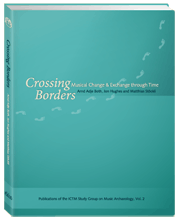Sounds from Under the Shifting Sands: Reflections on Kuchean Music Culture of the Sixth and Seventh Centuries
Gabriela Currie
A funerary box, currently part of the Otani Collection in the Tokyo National Museum, was unearthed in the early twentieth century from grounds surrounding the ruins of the Buddhist monastery of Subashi in Kucha province (today Xinjiang Uyghur Autonomous Region, China). It features a long procession of masked individuals dancing to the sound of a musical ensemble consisting of percussion, wind, and string instruments, along with music-making putti. The Otani box shares some decorative and music-iconographical motifs with two other boxes of similar provenance currently part of the Pelliot Collection at Musée Guimet in Paris. Together, these objects form a relatively homogeneous group of archaeological artefacts, both significant and thought-provoking from the standpoint of organological and music-iconographical analysis. A reading of their decorations in conjunction with representations of musicians and music making featured in the murals at Kizil, near Kucha, affords a unique perspective in deciphering some of the cultural practices in the ancient kingdom of Kucha during the sixth and seventh centuries CE. Furthermore, it enlists them as potential witnesses to the various processes of synthesis and diffusion representative of Eurasian transcultural commerce in the first millennium. More specifically, this article argues that the organological and music-iconographical elements under discussion belong to a system of signs that distinguish Kuchean musical culture during this period in two capacities: as having reached maturity through the interweaving of strands spun from diverse cultural geographies, particularly Indian and Persian; and as becoming an agent in the eastward transmission of new Central Asian cultural syntheses.




